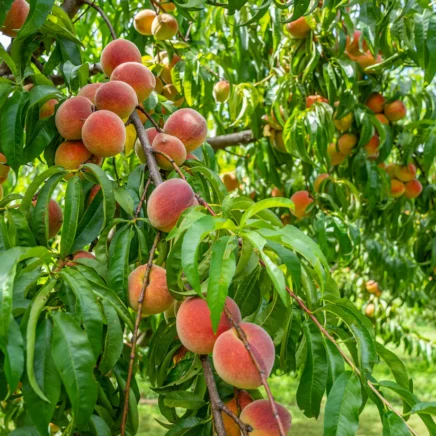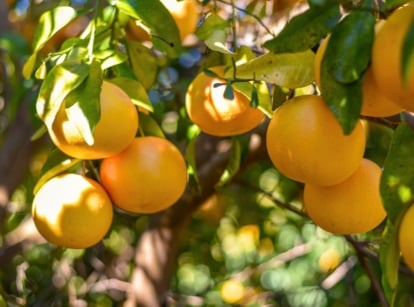Grow Your Fruit Trees Faster With This One Trick
If you're planting fruit trees this season, we have the lowdown on how to speed up growth by up to three years in only one! Read on to learn about Kevin and Jacques' method for growing your fruit trees faster.

Contents
We are rolling into spring, and coming right up on fruit tree planting season! If you’re adding some to your garden this year, we have a great planting method that can speed your tree’s growth by up to three years in just one.
Over the years, we have tried many different planting methods, and Kevin and Jacques have devised their own magic method. Their method will allow your fruit tree to spread its roots faster, and with the roots, the entire plant will grow larger in a shorter time.
Using this method means you can save money by purchasing a smaller tree. The expedited growth means your peach or mango will be ready to bear fruits much sooner. Read on to find out how you can use this planting method to grow fruit faster in your backyard garden or orchard.
Step 1: Water the Soil

Before you get rolling, ensure your soil is moist and ready for digging. If you’ve gotten plenty of rain recently, your soil should be easy to manage, but dry soil can be hard to work with. Give the ground a good soaking, allow the water to absorb, and then go back over it with more water to get that soil prepped.
Step 2: Measure and Define Your Hole

The key element of this planting method is the size and composition of the hole you are planting in. This won’t be your standard task because this hole needs to be much larger and deeper than usual. This loosens the soil in a larger space around the roots, allowing them to stretch out faster.
Measure out and mark a three-foot circle in the space where you want to plant. That may seem excessive if you’re accustomed to the standard way. That is, digging only slightly larger than your root ball and allowing the tree to adapt to the native soil. That has its benefits, but rapid growth is not one of them.
Step 3: Dig the Hole and Sort Your Soil

As you dig, you want to pay attention to the depth to ensure a fast-growing fruit tree. Separate the topsoil and subsoil into two piles. The topsoil is the first six inches to one foot of rich, loose dirt. Dig this out into one pile.
Beyond that, you will begin to see the composition change as particles get larger and the concentration of organic matter decreases. This is the subsoil. Place this in its own pile.
Tree roots don’t grow very deep. Research shows they prefer to stretch horizontally into the rich, loose topsoil. You can dig your hole wider if you have a larger root ball, but you typically don’t need to dig any deeper.
Step 4: Fork the Sides of the Hole

The deeper soil that you’ve dug into will be denser and more compacted than the topsoil in most cases. You may encounter a higher concentration of clay in this area, depending on your region. Digging into this can create a sort of pot that contains the roots of the tree.
The compacted walls of the hole will act as walls because they are harder for the roots to penetrate. This prevents the roots from fully stretching out and can inhibit their growth. The remedy for this is to lightly break up that wall to make it easier for them to penetrate.
You can use a pitchfork for this task if you have one. If not, a garden fork will work. It will just take a bit longer. Go around the walls with your fork and gently rough up the sides to help your fruit tree’s roots grow faster and easier into the surrounding soil.
Step 5: Gather Your Amendments

Part of this process involves mixing the different types of soil together. This not only improves the nutrient composition of the earth, but it creates better drainage as well. Drainage is important for preventing root rot.
You’ll need compost, the two piles of soil you removed from the hole, and a bag of topsoil, if you’d like. You’ll also need fertilizer and mulch a bit later on, so have those on hand, too. All-purpose fertilizer works well, or you can use a formula that is made specifically for your particular plant.
Step 6: Create and Compact Sub- and Topsoil

When you begin to fill the hole, create a layer of 20% compost, 20% top, and 60% subsoil. In mixing these together, you are loosening up that denser layer and adding rich organic matter. This will help drive your roots deeper and give them added nutrients as they go.
After you mix up this bottom layer, make sure to compact it well. You can do this by stepping firmly on the earth to press it down. Compacting it will remove some of the air pockets and prevent too much settling of this layer after you place your tree.
For your next layer, you’re finished with the sub and will focus on the topsoil. Use a mixture of 70% of that combined with 30% compost, and mix them together to combine.
Step 7: Place Your Rootball or Bare Roots

For the fastest growing and fruiting possible, make sure you’ve watered your tree ahead of time, as a hydrated plant transplants better. Dry roots are brittle and snap easily, and we don’t want to damage them and cause more stress.
Gently remove the pot. If you struggle to keep gophers and other digging animals, use a stainless steel mesh bag, which is often called gopher mesh. Place the root ball in the gopher mesh before you put it in the ground. The roots will be able to pass through the holes, but the digging animals will not be able to destroy them.
Place the root ball just slightly higher than the surface of the ground. Mix the remainder of your topsoil in with your remaining compost and fill in around the root ball. Tamp it down with your shovel or foot to compact those top layers.
Step 8: Add Fertilizer

Before you finish things off, add a generous amount of organic fertilizer all around the tree’s base. Although you’ve added plenty of nutrients by adding compost, those nutrients won’t be immediately available to your plant. They break down over time and become more available for use.
A quality, organic, granular fertilizer is perfect for helping a fruit tree grow and establish faster. If you want to use a formula created specifically for the type of fruit you’re planting, that will work well. Otherwise, a balanced formula is appropriate. Don’t go too light and sparing. Lay down about a pound of fertilizer here.
Step 9: Finish With Compost and Mulch

You don’t want the fertilizer to sit on the surface, so cover it up. Finish the fertilizer off with a layer of compost. Form a compost ring around the trunk, leaving a space between the trunk and the compost. It should look like a raised doughnut with a lower ring around the trunk.
Building this dirt doughnut serves an important purpose when you water. It helps to concentrate the water into the space around the trunk. The ring of compost keeps it from flowing away on the surface. Instead, the doughnut holds it in place until it can absorb into the earth.
Finally, cover the mound with a thick layer of mulch. While this won’t act as an amendment in the short term, over time, it will break down and enrich the soil. The mulch holds everything in place and also helps retain moisture
Similarly, apply the mulch to the top layer of compost. Cover the compost doughnut with the mulch, and maintain a ring of space around the tree trunk. Piling it up on the trunk can lead to rot and increase the risk of pest infestation.
Key Takeaways:
Using this method, you can take a younger, more economical fruit tree transplant and encourage it to grow much faster. The result is a savings of hundreds of dollars, combined with a situation that encourages your fruit tree to experience more rapid growth and development. That means you’ll have delicious fruit in your hands in a much shorter time.












